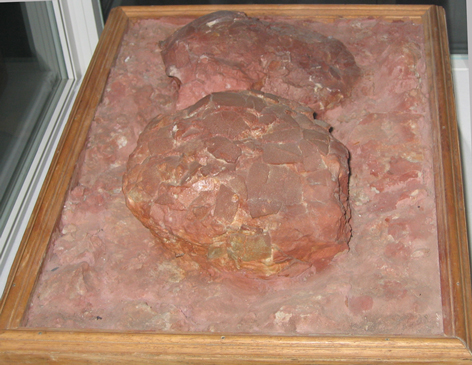A Dinosaur from Provence (France)
One of the first long-necked dinosaurs to be studied in Europe is a genus known as Hypselosaurus (pronounced hip-selo-sore-us). Large fossil bones had been unearthed in the French region of Provence in the 18th century, but it was not until the mid 1840s that these bones were scientifically studied. Dinosaur eggs have been discovered too. At first, the scientists and academics who studied the bones thought they belonged to an enormous, extinct crocodile, but the bones were ascribed to a dinosaur and Hypselosaurus was formally named in 1869.
A number of large, fossilised eggs were found at the same location as the fossil bones. The eggs, some of which almost thirty centimetres long are the biggest dinosaur eggs ever found in Europe. It was believed that the eggs must have been laid by the huge animal Hypselosaurus, although the eggs and body fossils may not belong to the same genus.
Fossilised Eggs Ascribed to Hypselosaurus
Picture credit: Everything Dinosaur
Dinosaur Eggs
The eggs are almost round in shape, sort of football sized (soccer ball). Studies have revealed that some of the eggs had thicker shells than others. Since the eggs are associated with Upper Cretaceous strata (Maastrichtian faunal stage), some scientists have suggested that the thin-shelled eggs found may provide a clue to the mass extinction event that occurred at the end of the Cretaceous. They have speculated that the thin egg shells may indicate that the animals that laid them were under stress and that dinosaur breeding and reproduction was being affected at this time.
Other palaeontologists have commented that the thinly-walled eggs seem to have hatched and perhaps the difference in thickness of shell material is related to ontogenic characteristics. Perhaps the thinner-walled eggs were laid by younger females.
Hypselosaurus
Recently, the genus known as Hypselosaurus has been re-evaluated. It has been declared “Nomen dubium”, that is a name given to an organism whose validity is in doubt. In the case of Hypselosaurus this is due to the fragmentary nature of the body fossils ascribed to this genus.
One interesting fact about the animal that laid these huge eggs (whatever that might be), based on volume and mass calculations, the animal that hatched from the eggs, and we assume a titanosaur, would have weighed at birth about as much as newborn baby human (7lbs-8lbs approximately). However, Hypselosaurus is estimated to have reached lengths in excess of ten metres and perhaps weighed as much as six tonnes – considerably bigger than any member of H. sapiens.
For models and replicas of titanosaurs: Titanosaurs and Dinosaur Models (Safari Ltd).







Leave A Comment